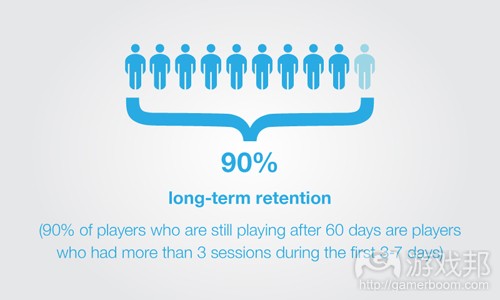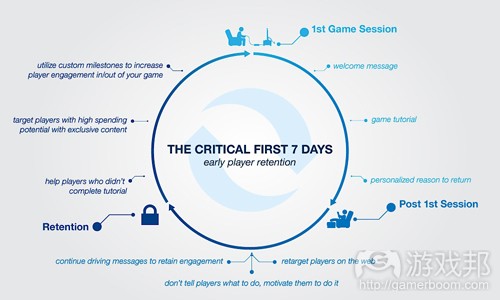以约会攻略比喻游戏留住玩家的策略
作者:John Cheng(Playnomics联合创始人)
在许多方面,可以将玩家留存率类比为从约会到求婚,即从第一印象到定下终身的长期过程。游戏发行商总是扮演着求婚者的角色,而所有潜在玩家都是他们的求婚对象。
就像约会,在早期吸引和留住玩家对于发展长期关系是至关重要的。事实上,从“留存初期”(玩家第一次进入游戏后的3到7天)上最能看出长期留存的可能性,因为玩家就是在这个阶段对你的游戏形成关键的第一印象,以及培养长期玩你的游戏的习惯。
为了增加长期留存率以及培养玩家对游戏毕生的忠实度,在头几天刺激玩家重复进入游戏是必须的。如果你认为留住玩家比不断开发新玩家更有效,那么把注意力高度集中于玩家的留存初期就是成功的关键。我们知道,过半的投资回报来自于坚持7天玩游戏的玩家。
本文将解释与开发和留住玩家最重要的方面。为了将早期留存引向长期留存和更好的赢利,我们拟定了3条定向策略。
继续上文提出的约会比喻,早期留存有三个关键因素:
1、发送信息(发出约会邀请)
2、计划新约会(约会后发信息给对方)
3、求婚早期的准备(向朋友介绍对方)
发送信息
如何通过发送信息创造新玩家的个性化体验
如果游戏发行商是单身汉,发送信息就是第一次约会中唯一能指望的了。在这个阶段,单身汉有很多约会对象可供选择。此时,营销和设计必须相结合,就像单身汉必须把自己打扮光鲜一样,不要只是指望对方。这不只是欢迎玩家,还要在第一次游戏时就利用所有机会向玩家传递能最大化留存率的信息。
发送信息有3个目标:
1)欢迎玩家,让玩家对游戏有好印象。
2)引导玩家完成游戏指南,根据玩家的水平匹配合适的训练关卡。
3)给玩家重回游戏的个性化理由。
不幸的是,大多数游戏只用一种“以不变应万变”的策略来欢迎玩家。对于第一次进入游戏的玩家,这是错误的欢迎办法。让玩家觉得自己受到欢迎的正确时机显然就落在玩家第一次进入游戏之时。严肃地说来,第一印象就是一切。你与玩家的第一次约会应该给他们留下足够多的操作和享受游戏的知识,但要保留刺激他们重回游戏的神秘感。
在游戏指南中,将信息作为游戏内部机制的组成部分自然地传递出来,也是很重要的。个性化体验对玩法步骤很有意义,也有助于玩家享受在这些宝贵时刻进行的活动——无论他们是更有经验的玩家还是新手。
最后,第一次约会就要结束了。真是美妙的约会,还想来第二次吗?时间自有答案,但现在,你还有一次机会给对方留下好印象——道别。把道别变得有价值,个性化。我们所有的约会都表明,个性化游戏内的欢迎信息(游戏邦注:如制定玩家来源或他们独有的游戏资料)会让玩家更愿意阅读、点击和回应。这就是为什么Playnomics总是鼓励玩家使用个性化的信息,特别是在留存早期。
以上就是PlayRM在30秒内完成动态欢迎信息的方法。
在本文的下一部分内容中,我们将探讨第二阶段的新约会策略。对于作为单身汉的游戏发行商,这就像第一次约会后发送短信或打一个至关重要的电话。如果你的玩家觉得第一次约会经历不错(如果你的第一次约会进展顺利,那就是了),你最好继续发动攻势。她可能就是那个命中注定的人!(本文为游戏邦/gamerboom.com编译,拒绝任何不保留版权的转载,如需转载请联系:游戏邦)
How to ask someone out: part 1 of Dating Strategies for Player Retention
by John Cheng
In many ways, player retention can be explained much the same as dating – courtship, if you will – for what will ultimately become a long-term relationship. Game publishers always play the role of suitor, and every potential player is the object of their affection…
And as with dating, engaging and retaining players early in the lifecycle is absolutely critical for long-term engagement. In fact, “Early Lifecycle Retention” (defined as the number of sessions played in the 3-7 days following a user’s first session) is the strongest predictor of long-term engagement because players are forming crucial first impressions about your game and habits about how they will play and interact with your game long-term.
Driving repeat visits in the first few days is essential for increasing LTV and player engagement that will continue throughout a player’s lifecycle. If you believe as we do that it’s more effective to keep a player than to continuously acquire new ones, then having a highly focused plan for Early Player Retention is key to success. We’ve seen up to 5x the ROI from players who make it to day seven.
This series will shed light on some of the most critical aspects of acquiring and keeping your most valuable assets up front. We’ll examine three targeted messaging strategies for Early Player Retention that leads to longer, better-monetized player engagement.
Carrying on with our bachelor metaphor, three key factors for Early Player Retention:
Part 1 – Onboarding message (asking her out / the first date)
Part 2 – Post session retargeting (texting her after your date)
Part 3 – Early engagement segmentation (what you tell your friends about her)
ONBOARDING MESSAGE
How to Create a Personalized Experience for New Players through Messaging
If game publishers are bachelors, the onboarding process is everything you’d expect from a first date. Here’s where a suitor has multiple, significant opportunities to interact with their “date” (player) right off the bat. Marketing and design must work together in onboarding, just like a bachelor needs to be charming, not just look the part. It’s not just about welcoming a player; it’s about taking every opportunity in their first session to communicate messaging that maximizes retention.
Onboarding messaging has three goals:
1) Welcome the player and set the right tone for your game.
2) Shepherd players through the tutorial process, matching the right level of education to each person’s expertise.
3) Give players a personalized reason to come back and play those critical next sessions.
Unfortunately, most games have a one-size-fits-all approach to welcoming players. This is the wrong way to speak to someone who has essentially just walked into your game. The right time to make someone feel welcome in your game should obviously be during a player’s first session. First impressions mean everything, seriously. Your first date with a player should leave them with enough knowledge to play and enjoy the game, but enough mystery to come back for more.
In tutorials, it’s also important to naturally weave in the onboarding messaging as a complement to the in-game mechanics. Personalizing the tutorial experience adds value to gameplay steps and actions that a player takes during those precious moments when they’re learning about your game – whether they’re more experienced players or not.
Finally, the first date is ending. Oh it was lovely. Will there be a second? Time will tell, but for now, you have one more opportunity to leave a good impression – the goodbye. Make it count. Make it personal. All of the data we have says that personalized in-game welcome messages (i.e. tailored to where a player came from or their particular play profile) more are likely to be read, clicked on and responded to. This is why Playnomics always encourage our customers to use personalized messaging, especially for Early Lifecycle Retention.
Here’s how you’d set up a dynamic welcome message in PlayRM in thirty seconds.
In the next part of this series, we’ll talk about strategies for post-session retargeting. For bachelor game publishers, this is like sending a text message or making that ever-critical phone call after the first date. If your player enjoyed their first experience (if your first date went well, that is), you’d better make sure to follow up afterward. She could be the one!
About the author: John Cheng is a co-founder of Playnomics and leads product vision and development for the team. He focuses on maintaining a close dialogue with customers and tailoring the product to meet their needs.
Founded in 2009, Playnomics provides technical solutions for quantifying play behavior. Its flagship product, the PlayScience Engine, scores over 30 million monthly active players across dozens of the leading online games and brands worldwide. In 2012, Playnomics launched a CRM platform for games called PlayRM?. (source:gamesbrief)










































